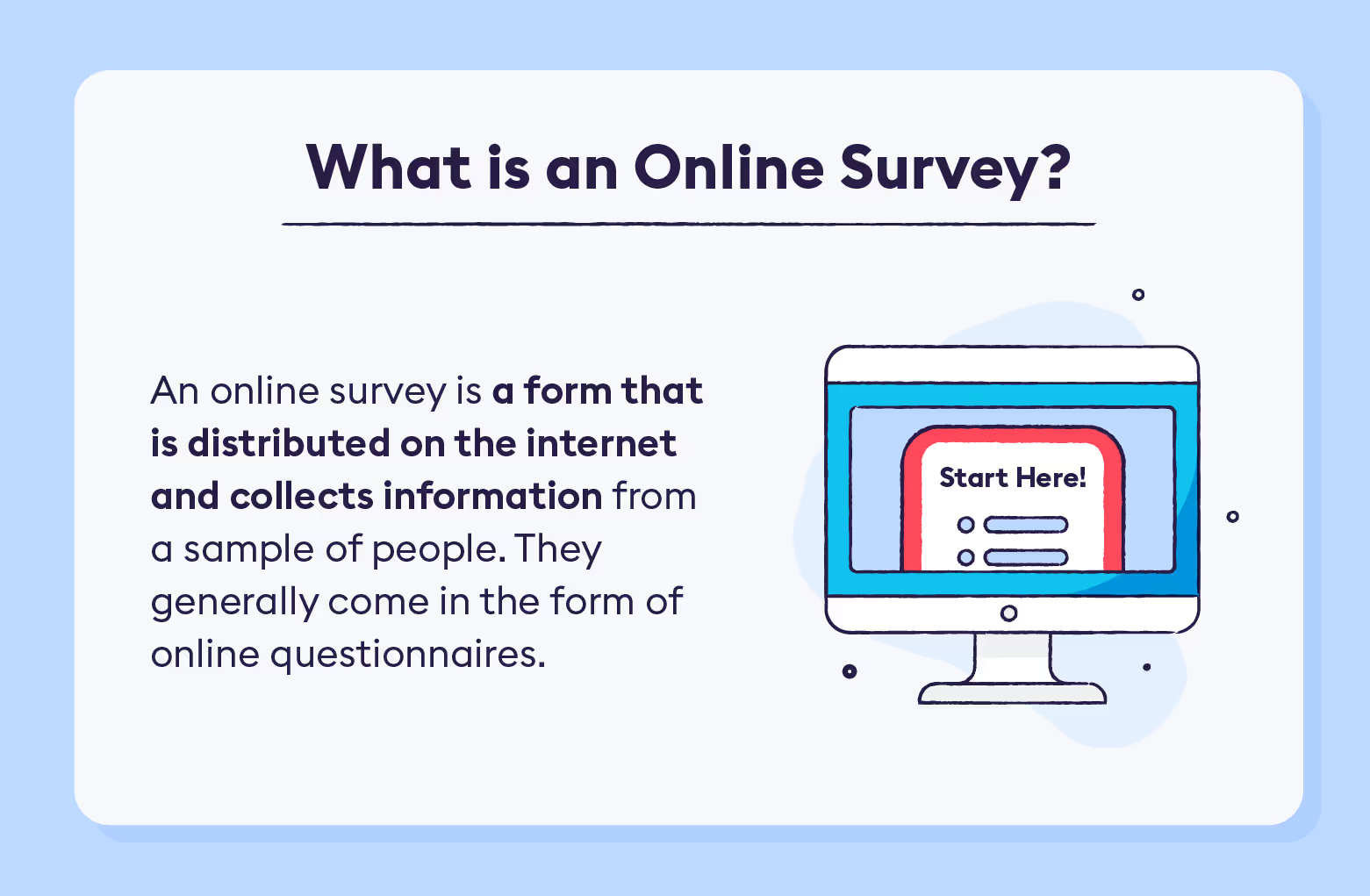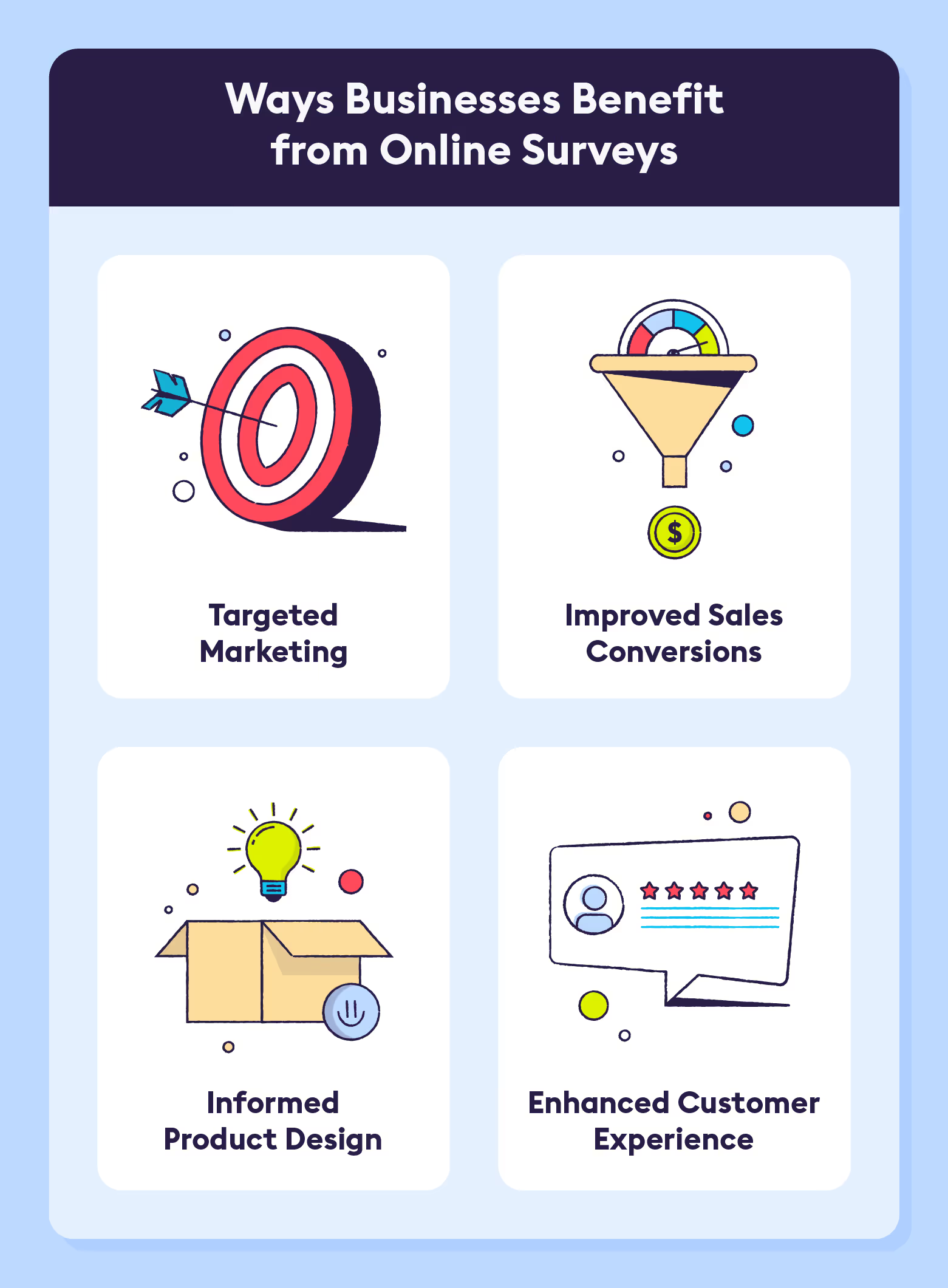
Online surveys are an important tool for businesses to learn more about their customers and their goals. They’re a quick, cheap, accurate, and convenient way to gain insights about customer feedback, so it only makes sense for a company to take advantage of these benefits to further understand their audience. Conducting an online survey, however, can be a daunting process if you’ve never done it before.
To help anyone learn how to create and conduct an online survey, we’ve broken down the process into 12 simple steps. Remember to jump down to the infographic for a visual representation of this process.
What Is An Online Survey?
An online survey is the process of collecting information on the internet from a desired audience and then analyzing the aggregated data. Surveys are often interchangeably referred to as questionnaires, but a survey encapsulates the entire process from data collection to analysis. A questionnaire is simply a set of questions that is used as a tool to collect data.

Steps To Create A Successful Online Survey
Although creating online surveys can be relatively simple and easy thanks to online survey platforms, it can be hard to figure out where to start. Use the following step-by-step guide to craft a survey that generates actionable insights for your business.
1. Understand The Survey’s Goals
When creating a good online survey, it’s important to always keep in mind the survey’s goals. Business goals will inform the direction of the survey, the types of questions asked, who is surveyed, and the eventual analysis of the results.
For example, if a company is looking to launch a new product or service offering, a survey can help the company gain insight into what their customers need and want. If a business is looking to change their branding, surveys can help gauge customer sentiments and influence the direction of the change so that customers stay happy. Keep your goals in mind when designing a survey so that time, effort, and resources aren’t wasted on a survey that doesn’t accomplish what it was meant to do.
2. Determine The Best Survey Type Based On Frequency
After establishing the survey’s goals, it’s helpful to choose the best survey type to accomplish those goals. There are three main types of surveys: cross-sectional, longitudinal, and retrospective. Learn more about each survey type below and pick the type that helps accomplish the survey’s goal.
Cross-sectional surveys
The most common surveys are cross-sectional surveys, which involve surveying unique samples of people at one point in time. Cross-sectional surveys are good for gauging attitudes or feedback at a particular point in time. A one-time customer feedback survey asking about thoughts and opinions on the usability of your brand’s current website, for example, can be classified as cross-sectional.
Longitudinal surveys
On the other hand, longitudinal surveys survey a sample of people multiple times over a certain period of time. An example of this would be if you surveyed a specific sample of customers about a product in its beta phase and then also surveyed that same sample about the product once it was finalized. Longitudinal surveys are best for tracking trends or identifying change in a group over time.
Retrospective surveys
When a survey asks participants to report feedback based on a past experience, this is considered a retrospective survey. It’s similar to a cross-sectional survey, but can help save time and resources by retroactively gathering data on something that already happened. For example, if a business ran a huge flash sale or had an in-person pop-up store, and then asked customers for feedback a few weeks later, this would be a retrospective survey.

3. Develop Research Questions
Once the type of survey is chosen, it’s time to develop the survey questions. Most online surveys gather data using a questionnaire, so it’s important to come up with good survey questions that answer targeted questions about your customers and deliver useful results.
If your business is looking for quantitative data to inform things like business strategy or customer experience, closed-ended questions, such as multiple choice, can help gather that information. On the other hand, if improving marketing or advertising campaigns is the goal, open-ended questions may be necessary to generate qualitative data.
4. Consider Survey Organization And Flow
After developing a set of research questions, it’s necessary to organize them logically and in a way that prevents respondents from becoming confused or fatigued. For instance, if the survey was a mix of closed-ended and open-ended questions, it’s best to start with the closed-ended questions and save the open-ended questions for later. This is because open-ended questions are generally more cognitively demanding than closed-ended questions, and it’s important to be aware of how fatigued respondents are because it can affect the quality of their responses.
Additionally, questions should follow a logical order. Group similar questions together and explain any transitions between sets of questions so the participant isn’t confused. If a certain question contains a requirement for another question, make sure that they are ordered sequentially. For example, if homeowners are the target audience, it’s necessary to first ask whether the respondent owns a home, before following up with a question that asks if they’ve ever completed a home renovation project. It’s crucial to always review the flow of a survey in order to evaluate whether it flows well and the order makes sense.
5. Forecast Challenges And Solve Them Early
While creating a survey, it’s wise to think about what challenges might affect the survey results and solve for them before they happen. Complex vocabulary can cause confusion and influence the quality of the data collected, so it’s important to define uncommon terms and use examples when possible. If using examples, try to make them neutral or unrelated to the question, so the participant isn’t primed to respond a certain way.
Another common obstacle in surveys is dealing with human error. If your business needs feedback on a particular service, every person’s memory may not be consistently accurate. Some may be unable to recall the experience or might even have a false memory about it. One way to get around this is to use a memory recall prompt, which asks respondents to describe the experience in question. After describing the event, respondents will have a better memory when asked to rate the quality of services or provide detailed feedback on the experience.
6. Think About Offering Incentives
If possible, consider offering people an incentive to take your survey. Incentives can come in the form of gift cards, discounts, free samples or downloads, a raffle entry, or even a certain amount of monetary compensation. This will encourage more people to participate in the survey and also help improve the quality of responses.
Many surveys don’t offer any compensation, so if it’s not in the company budget, feel free to conduct a survey without one. Additionally, it’s good to be aware of how an incentive may bias your respondents. For example, if you’re interested in customer satisfaction, people may be less inclined to share negative feedback if they’re being compensated with a gift card or money. Keep this in mind when choosing to offer an incentive and make sure it doesn’t affect the survey’s goals.
7. Distribute The Survey To Participants
Once your survey is ready, you’ll need to choose the best way to distribute it to your sample. Thanks to the ease of the internet, online surveys are easy to administer through email, text, QR code, or even a link on your business’s website. When choosing a survey distribution method, keep your audience in mind and pick a channel that they actually engage in. Analytics can help determine at what point in the customer journey people engage the most and what channels will be the most effective.
8. Collect Enough Survey Responses
After distributing your survey, it’s time to watch the responses roll in. It’s important to work out the sample size you may need to properly analyze your results later. Use a sample size calculator to determine how many responses are necessary to be able to make generalizations that are representative of your target group.
Make sure to monitor the response rate of the survey. If the response rate is low, take actions to adjust the distribution method to improve participation. Try adjusting email subject lines or the survey’s call to action so that it is brief, urgent, and personalised.
9. Perform Data Analysis
When a large enough sample has been reached and data collection has ended, it’s time to analyze the results. Survey data analysis will depend on what kind of data was collected. Perform statistical analysis of quantitative data and then visualize it with tables, graphs, and charts. Inductive or deductive coding helps interpret qualitative data and translate it into meaningful themes or usable quantitative tags.
A helpful tip is to always keep a raw, unedited copy of the survey data and create a copy to do your analyses in. This way a backup is available in case a mistake occurs, and it will be easy to start over from scratch without losing data.
10. Generate A Report
Now that the data is analyzed, it’s time to create a report that presents and explains your findings. A good report will address whether the survey’s goals were met and offer actionable takeaways for the company to implement moving forward. If goals aren't met, then it’s helpful to reflect on why that happened and what can be improved in future surveys.
On the other hand, if your survey did meet its goals, use the report as evidence to suggest specific objectives for improving your business. Say for example the survey revealed that 60% of customers are unsatisfied with their experience on your website. Use this statistic as justification to suggest initiatives that will enhance customer experience, like hiring additional customer service representatives or implementing a chatbot service.

11. Implement Findings
After survey findings are reported, it’s important to follow through with actions. Take the specific objectives outlined in the report and plan out how to execute them. Using the above example for improving customer experience, create a timeline to hire new customer service representatives or allocate financial resources to invest in a chatbot. Acting on your survey results will make it worthwhile for your business and help achieve the original goals.
12. Improve The Process For The Future
Once the entire survey process is complete, take time to think back about what went well and what didn’t. Make notes of any pain points that popped up during the creation, distribution, analysis, and reporting stages, and find ways to improve them the next time around. Surveys are important tools for leveling up any business, and the more refined the process is, the better the outcomes.
Using this step-by-step guide on how to conduct an online survey, any company can reap the benefits of cost-effective and convenient business insights. Looking to refine the survey process even more? Check out the visual below for additional dos and don’ts of online surveys or sign up for a demo to see how Chattermill’s dashboards can make the process even easier.

Sources: Learning Hub















